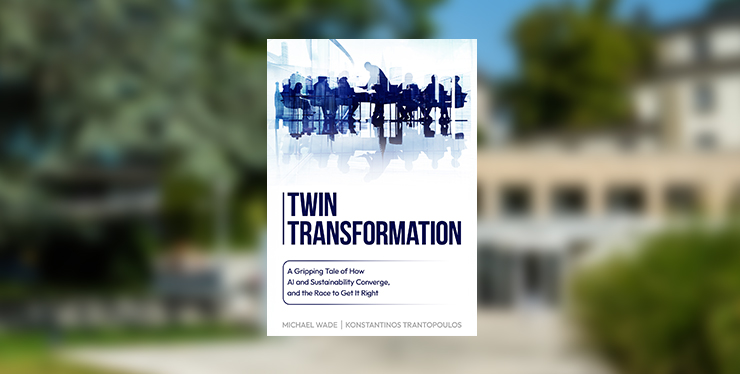
This webinar, led by Professor Vanina Farber, elea Chair of Social Innovation and Susana Robledo Reber, previous Sustainability Innovation Manager and now Global Brand and Sustainability Strategy Manager at Nestlé Nespresso, appeared live on Wednesday, August 19th at 11am CEST.
What does microinsurance have to do with assuring the sustainability of coffee in the future? How do smallholder coffee farmers make use of insurance pay outs to maintain quality coffee? And, what is the role of large coffee buyers such as Nespresso?
These are some of the questions asked in this webinar, hosted by Professor Vanina Farber and guest speaker Susana Robledo Reber, from Nestlé Nespresso.
Professor Farber mentioned that, in the context of COVID-19, many ESG funds or sustainable businesses have financially outperformed other firms. Research indicates that this outperformance, in COVID times and beyond, reflects firms’ responses to material issues. The challenge facing many executives today is that they aren’t sure where to start their ESG efforts.
On the topic of ESG materiality issues, Professor Farber reminded her audience of the definition of materiality, according to the Global Reporting Initiative (GRI):
“Determining materiality for a sustainability report includes considering economic, environmental, and social impacts that cross a threshold in affecting the ability to meet the needs of the present without compromising the needs of future generations.”
Susana Robledo Reber helped to create the “Reviving Origins” coffee product range that engages with consumers on sustainability issues and works in countries in Latin America and Africa at risk of disruption due to extreme weather or political change.
Having worked closely with the Colombian government and a range of other stakeholders from a variety of sectors in the context of Nespresso’s AAA program, Robledo Reber draws on several examples during this webinar.
What did Nespresso do to mitigate the risk of climate change on coffee production?
“By 2050, it’s estimated that current coffee supply will have been halved if we do nothing,” said Susana Robledo Reber.
She went on to describe the unique features of Nespresso’s “AAA” program: “a farmer relationship program acting at three levels.”
The initiative works on several levels: with individual farmers, with communities and with the geographical landscape.
With 110,000 farmers in 15 countries, the program not only addresses climate change but also the social issues that affect farmers’ livelihood and well-being.
What role do certifications like Fair Trade play in the sustainability of coffee and are they enough?
“Certifications are critically important, but they aren’t always enough,” said Robledo Reber. Narrating the experience of Nespresso, she said such seals of approval cannot guarantee the well-being of farmers at all levels.
“Farmers are vulnerable to two main risks: market and price volatility and of course, climate change.”
Farmers have been participating directly in the program from 2014, identifying two main risks: the lack of access to pensions and climate shifts that affect their crops.
Aware that just 7% of farmers have access to a pension, Nespresso began a partnership with Fairtrade which saw 1,000 farmers begin to save for their retirement in 2015.
How did Nespresso start to provide pension schemes to smallholder farmers?
“We chose to start with pensions and later on address the climate challenge,” said Susana Robledo Reber.
“The government at the time was setting up a program to support pensions,” she added, explaining how it was an opportune moment to get things underway.
What were the challenges and opportunities of partnering with the Colombian government?
In a country of more than 50 million people, 7 million do not have access to a pension.
“The government wanted to partner with us because we had access to the smallholder farmers and to information.”
“On one hand, it was great partnering with the government because we could really go big. On the other, the main challenge was speed,” said Robledo Reber, in reference to the rate at which initiatives can be implemented with the government’s support.
“What we wanted to ensure at Nespresso as we entered this new zone for us,” said Robledo Reber “is that the money people were investing into their pensions was protected.”
“In the past, people had had fewer positive results with private pensions and we were therefore very cautious about handling retirement savings,” she explained.
How did the pension program work?
The government set up a fund into which smallholder farmers could place money via individual accounts, as they liked and as often as they wished. The government topped up a further 20% of the total amount saved.
Among other reasons, it has been the inability of this population to accumulate savings that has discouraged younger generations from choosing to remain in coffee farming.
Robledo Reber explained that the pension scheme helped to address the generational continuity issue among smallholder coffee farmers in Colombia, where pensions were perceived as an incentive.
The cooperative managed the premiums paid on Fairtrade coffee, which meant money could be reinvested in the cooperative to extend the pension program to more farmers.
Robledo Reber explained the deep commitment Nespresso has towards ensuring the long-term sustainability of coffee production, given it’s a core resource.
“With climate change causing huge disequilibrium in coffee production and with only a small percentage of farmers having access to a pension, we need to help reduce risk.”
How was impact measured?
Robledo Reber described the overall KPIs that helped determine the extent of the program’s impact. “The best example of impact is the number of people receiving pensions,” she says, noting that 170 people are currently drawing pensions from the fund for their retirement.
Robledo Reber also highlighted several other impressive results:
“$6.3 million has gone into the pension fund so far,” she said. Also, thousands of farmers have joined the program and the initiative has been extended beyond Colombia to Indonesia. Add to that the fact that 30% of farmers have saved additional funds independently.
From pensions to insurance
By 2017, Nespresso was ready to start addressing the second major risk facing farmers: climate change.
That year saw the creation of a crop insurance, which was launched in Colombia in 2018.
“I’ve spoken to insurance companies and they say how difficult it is to reach smallholder farmers with commercially available mechanisms,” said Professor Farber.
She described the risks that traditional insurance companies face. There are major challenges to insuring smallholder farmers, such as the cost of distribution and the multitude of risks (credit, market, health, natural) that farmers face.
Professor Farber also described the enormous challenge of high transaction costs to assess damage due to climate change. “Why would you, as a corporate, get involved? What assets did you leverage to confront this challenge?” she asked Robledo Reber.
Aligning incentives to bring better collaboration
“It’s very expensive to go and visit every farm to evaluate losses, and this is even worse in the context of COVID-19,” said Robledo Reber.
“Many pilot programs were started in Colombia and Brazil,” said Robledo Reber. “It wasn’t easy to deliver results due to the high cost and also because people were sceptical of whether pay outs would be made in the event of a claim.”
“We started to work with a local insurance operator who worked closely with the cooperative. We also worked with a company that provides modelling for insurances as well as the University of Colombia who are experts on climate. Lastly, we collaborated with Blue Marble.”
Blue Marble is the program’s insurance partner, a social enterprise consortium collaborating to extend socially impactful, commercially viable insurance protection to hard-to-reach populations like smallholder farmers, with a multi-stakeholder partnership also underway with Seguros Bolivar, a local insurance operator.
Paying premiums for weather-indexed crop insurance
Robledo Reber explained the approach Nespresso used to limit the exposure of smallholder farmers during the pilot phase of the program.
“During the pilot phase, we paid the insurance premiums, not the farmers, to ensure we had built the right product,” she said.
“We needed to gain trust with the farmers first, so they could see we were not finding ways to make money but rather offering a way to protect them from climate risks.”
A microinsurance consortium was created by Blue Marble that could bring in talent from all the insurance companies with whom they collaborated.
They created a program that provides a shift from traditional insurance in which each loss is verified. In the case of smallholder coffee farms in Colombia, the cost of such verification can be very expensive.
Blue Marble helped to establish an innovative satellite-based or index-based insurance. “This is really new in agriculture,” said Reber.
Robledo Reber explains the technicalities of how the indexing works. By splitting farms into 5km by 5km areas and measuring weather variations, insurance pay outs would be made to all farmers within the affected area, using highly accurate and data-driven information to determine the extent of losses.
Building trust with smallholder farmers
“We often go to the farms,” said Robledo Reber. “We’ve been going to farms for years and while COVID-19 doesn’t allow for that proximity anymore, we have built trust with the farmers.”
To corporates seeking to provide similar insurance coverage to smallholders, Robledo Reber advised “it’s of utmost importance to build trust with your communities before creating the insurance.”
Sharing knowledge and experience of Nespresso
Robledo Reber explained that Nespresso has been active on sustainability issues for many years but has probably not communicated enough about them. She also explained the image of Nespresso’s products being associated with luxury.
“Before, sustainability and luxury weren’t associated but we see that changing now,” says Robledo Reber.
“With climate change affecting all of us, there’s more of an opportunity now for us to share what we’re doing and have that conversation.”
“This is an opportunity for other corporates to learn from this example of collaboration and a corporate having a catalytic role initiating innovative solutions that sometimes go beyond what you would think a corporation should do,” said Professor Farber.
What’s next?
“We’re opening our pilots to other regions,” says Robledo Reber. She explained the intention is not for Nespresso’s experience to remain with the company but to catalyse innovation and drive knowledge among other corporates and stakeholders who would like to get involved.
The experience of Nespresso is reflective of the challenges facing many other firms in today’s globally connected supply chains.
The social, economic or environmental challenges that societies face in the coming decades will force corporations, governments and civil society organizations to tackle them globally with responsibility, creativity and urgency.
By first identifying material ESG issues that affect their value chains, firms can then look towards collaboration opportunities that bring in the competencies of cross-sector partners.
With the right incentives, cross-sector initiatives such as Nespresso’s foray into insurance demonstrate the type of social innovation that we seek to encourage at the elea Center for Social Innovation.
To find out more about upcoming webinars from the elea Center for Social Innovation, please visit the Center’s page here.









